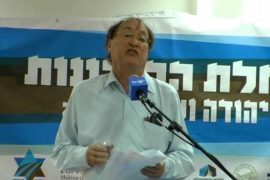1) At the Fathom Journal, Calev Ben-Dor discusses some assessments of the Iranian regime’s attack on Israel.
“Two key parameters can help us understand the strikes’ significance and seriousness. One is their point of origin – primarily from Iranian territory rather than via proxies (although missiles were also fired from Iraq and Yemen). The second is the quantity. ‘I’m not willing to describe a situation in which Iran fires over 300 drones, ballistic and cruise missiles from their own territory as purely symbolic’ Raz Zimmt, researcher at the Alliance Center for Iranian Studies at Tel Aviv University, tells Fathom. ‘I don’t see how this can be understood as a calibrated attack intended to prevent escalation’ he adds.”
2) At the Free Press, Matti Friedman explains how ‘The Real War in the Middle East Comes into Focus’.
“For the past six months, since the Hamas massacres of October 7, the ideological forces arrayed against Israel have done their best to make this seem like a war in which there are two sides, and that these sides are Israeli soldiers and Palestinian civilians. This information campaign is as critical to Israel’s enemies as the physical war, because it erodes the Western support that Israel needs to win and survive. Its successful execution has turned a jihadi war against the Jewish minority enclave in the Middle East into a story about Jewish oppression and even “genocide” of Palestinians, a story that has become the focus of the increasingly deranged discourse in the liberal West.”
3) UN Watch looks at ‘UNRWA’s Rigged “Independent” Review’.
“On February 5, 2024, UN Secretary-General Antonio Guterres announced the appointment of an “Independent Review Group” with the stated purpose of assessing whether the United Nations Relief and Works Agency for Palestine Refugees in the Near East (UNRWA) “is doing everything within its power to ensure neutrality and to respond to allegations of serious breaches when they are made.”
The announcement came shortly after 18 top donor states to UNRWA suspended funding to the agency, due to revelations that at least 12 UNRWA staffers participated in the October 7th massacre and that hundreds of the agency’s employees are operatives of Hamas and Islamic Jihad. […]
A brief examination of all of the parties involved in the review group confirms that they are not unbiased, objective observers.”
4) At the INSS, Orit Perlov analyses recent events in Jordan.
“Jordan’s stability is being undermined by mass demonstrations outside the Israeli embassy in Amman, organized by the National Forum for Supporting the Resistance and spearheaded by the Muslim Brotherhood in Jordan. Iranian subversion, and the use of the Hashemite Kingdom for smuggling weapons and money to terrorist organizations in the West Bank are also contributing to the instability.”
5) At the JCPA. Khaled Abu Toameh asks ‘Is the Palestinian Authority Trying to Return to Gaza?’.
“The alleged attempt by PA intelligence officers to operate inside the Gaza Strip has aggravated tensions between the PA and Hamas. It’s hard to see how the new PA government, or any Arab peacekeeping force, would manage to function in the Gaza Strip while Hamas maintains multiple battalions and thousands of militiamen, especially in the southern parts of the coastal enclave.”
6) At the Alma Center, Boaz Shapira provides a report on the ‘Islamic Revolutionary Guard Corps – Navy (IRGCN)’.
“Along with its well-known activities in the Arabian Gulf and the Gulf of Oman, the IRGCN also began to establish itself in other arenas. These now include the Arabian, Red, and Mediterranean Seas. Senior Iranian officials have also expressed a desire to establish a presence in the Panama Canal Zone as well as the South Pole. This increased activity, combined with Iran’s success in producing UAVs, cruise missiles, and anti-ship missiles, has made it a tangible threat to global marine commercial traffic, as well as to numerous countries in the Middle East and beyond.”




